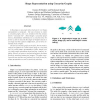Free Online Productivity Tools
i2Speak
i2Symbol
i2OCR
iTex2Img
iWeb2Print
iWeb2Shot
i2Type
iPdf2Split
iPdf2Merge
i2Bopomofo
i2Arabic
i2Style
i2Image
i2PDF
iLatex2Rtf
Sci2ools
91
Voted
ICPR
2002
IEEE
2002
IEEE
Shape Representation Using Concavity Graphs
In this paper, a new graph data structure for 2-D shape representation is proposed. The new structure is called a concavity graph, and is an evolution from the already known "concavity tree". Even though a concavity graph bears a fundamental resemblance to a concavity tree, the former is able to describe the shape of multiple objects in an image and their spatial configuration, and is hence inherently more complex. The aim of concavity graphs is two-fold: first we want to analyze the patterns in a multi-object image in a way that will (1) provide better representation of their shapes, and (2) convey useful information about how they "interact" together. Second, we want our analysis technique to facilitate similarity matching between two images. This paper introduces the new structure and outlines how it can be used for shape representation as well as similarity matching.
2-D Shape Representation | Computer Vision | Graph Data Structure | ICPR 2002 | Similarity Matching |
Related Content
| Added | 09 Nov 2009 |
| Updated | 09 Nov 2009 |
| Type | Conference |
| Year | 2002 |
| Where | ICPR |
| Authors | Ossama El Badawy, Mohamed Kamel |
Comments (0)

